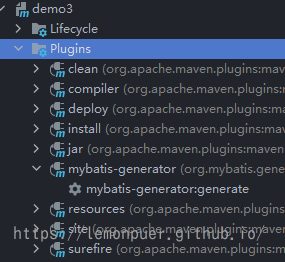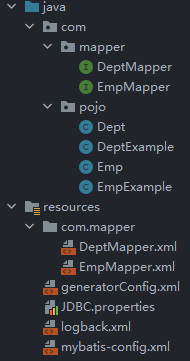1. MyBatis简介 MyBatis最初是Apache的一个开源项目iBatis,iBatis3.x正式更名为MyBatis。代码于 2013年11月迁移到Github。
iBatis一词来源于“internet”和“abatis”的组合,是一个基于Java的持久层框架。 iBatis提供的持久层框架 包括SQL Maps和Data Access Objects(DAO)。
特性:
MyBatis 是支持定制化 SQL、存储过程以及高级映射的优秀的持久层框架
MyBatis 避免了几乎所有的 JDBC 代码和手动设置参数以及获取结果集
MyBatis可以使用简单的XML或注解用于配置和原始映射,将接口和Java的POJO(Plain Old Java Objects,普通的Java对象)映射成数据库中的记录
MyBatis 是一个 半自动的ORM(Object Relation Mapping)框架
Hibernate 是一个全自动的ORM框架,可以自动生成SQL语句,自动执行。
ORM框架采用元数据来描述对象与关系映射的细节,元数据一般采用XML格式,并且存放在专门的对象一映射文件中。简单理解为一种框架的格式
对比:
JDBC:
SQL 夹杂在Java代码中耦合度高,导致硬编码内伤
维护不易且实际开发需求中 SQL 有变化,频繁修改的情况多见
代码冗长,开发效率低
Hibernate 和 JPA
操作简便,开发效率高
程序中的长难复杂 SQL 需要绕过框架
内部自动生产的 SQL,不容易做特殊优化
基于全映射的全自动框架,大量字段的 POJO 进行部分映射时比较困难。
反射操作太多,导致数据库性能下降
MyBatis
轻量级,性能出色
SQL 和 Java 编码分开,功能边界清晰。Java代码专注业务、SQL语句专注数据
开发效率稍逊于HIbernate,但是完全能够接受
环境搭建 MyBatis下载地址:https://github.com/mybatis/mybatis-3
由于现在我们引入jar包都是用Maven,所以这里下载的目的主要是获取官方文档
依赖引入:
1 2 3 4 5 6 7 8 9 10 11 12 13 14 15 16 17 18 19 20 21 <dependencies > <dependency > <groupId > org.mybatis</groupId > <artifactId > mybatis</artifactId > <version > 3.5.7</version > </dependency > <dependency > <groupId > junit</groupId > <artifactId > junit</artifactId > <version > 4.12</version > <scope > test</scope > </dependency > <dependency > <groupId > mysql</groupId > <artifactId > mysql-connector-java</artifactId > <version > 8.0.26</version > </dependency > </dependencies >
MyBatis的核心配置文件 习惯上命名为mybatis-config.xml,将来整合Spring 之后,这个配置文件可以省略。
核心配置文件主要用于配置连接数据库的环境以及MyBatis的全局配置信息
1 2 3 4 5 6 7 8 9 10 11 12 13 14 15 16 17 18 19 20 21 22 23 <?xml version="1.0" encoding="UTF-8" ?> <!DOCTYPE configuration PUBLIC "-//mybatis.org//DTD Config 3.0//EN" "http://mybatis.org/dtd/mybatis-3-config.dtd" > <configuration > <environments default ="development" > <environment id ="development" > <transactionManager type ="JDBC" /> <dataSource type ="POOLED" > <property name ="driver" value ="com.mysql.cj.jdbc.Driver" /> <property name ="url" value ="jdbc:mysql://localhost:3306/test" /> <property name ="username" value ="root" /> <property name ="password" value ="123456" /> </dataSource > </environment > </environments > <mappers > <mapper resource ="com/user/UserMapper.xml" /> </mappers > </configuration >
创建mapper接口 1 2 3 4 5 6 7 8 public interface UserMapper { int addOne () ; int updateOne () ; int deleteOne () ; }
创建MyBatis的映射文件 相关概念:ORM(Object Relationship Mapping)对象关系映射。
对象:Java的实体类对象
关系:关系型数据库
映射:二者之间的对应关系
映射文件的命名规则:表所对应的实体类的类名+Mapper.xml
表t_user,映射的实体类为User,所对应的映射文件为UserMapper.xml
因此一个映射文件对应一个实体类,对应一张表的操作,MyBatis映射文件用于编写SQL,访问以及操作表中的数据,存放在src/main/resources目录下
MyBatis中可以面向接口操作数据,要保证两个一致:
mapper接口的全类名和映射文件的命名空间(namespace)保持一致
mapper接口中方法的方法名和映射文件中编写SQL的标签的id属性保持一致
1 2 3 4 5 6 7 8 9 10 11 12 13 14 15 16 17 18 19 <?xml version="1.0" encoding="UTF-8" ?> <!DOCTYPE mapper PUBLIC "-//mybatis.org//DTD Mapper 3.0//EN" "http://mybatis.org/dtd/mybatis-3-mapper.dtd" > <mapper namespace ="com.user.UserMapper" > <insert id ="addOne" > insert into user values (null, '张三', '123', 'foshan', '123') </insert > <update id ="updateOne" > update user set name='张三' where name = 'john' </update > <delete id ="deleteOne" > delete from user where name='张三' </delete > </mapper >
获取代理对象mapper 1 2 3 4 5 6 7 8 9 10 11 12 13 14 15 16 InputStream is = Resources.getResourceAsStream("mybatis-config.xml" );SqlSessionFactoryBuilder Builder = new SqlSessionFactoryBuilder ();SqlSessionFactory Factory = sqlSessionFactoryBuilder.build(is);SqlSession sqlSession = sqlSessionFactory.openSession(true );UserMapper mapper = sqlSession.getMapper(UserMapper.class);System.out.println(mapper.addOne());
SqlSession:代表Java程序和数据库之间的会话。(HttpSession是Java程序和浏览器之间的 会话)
SqlSessionFactory:是“生产”SqlSession的“工厂”。
工厂模式:如果创建某一个对象,使用的过程基本固定,那么我们就可以把创建这个对象的 相关代码封装到一个“工厂类”中,以后都使用这个工厂类来“生产”我们需要的对象。
加入log4j日志功能 加入依赖
1 2 3 4 5 6 <dependency > <groupId > log4j</groupId > <artifactId > log4j</artifactId > <version > 1.2.17</version > </dependency >
加入log4j的配置文件:
log4j的配置文件名为log4j.xml,存放的位置是src/main/resources目录下
1 2 3 4 5 6 7 8 9 10 11 12 13 14 15 16 17 18 19 20 <?xml version="1.0" encoding="UTF-8" ?> <!DOCTYPE log4j :configuration SYSTEM "log4j.dtd" > <log4j:configuration xmlns:log4j ="http://jakarta.apache.org/log4j/" > <appender name ="STDOUT" class ="org.apache.log4j.ConsoleAppender" > <param name ="Encoding" value ="UTF-8" /> <layout class ="org.apache.log4j.PatternLayout" > <param name ="ConversionPattern" value ="%-5p %d{MM-dd HH:mm:ss,SSS} %m (%F:%L) \n" /> </layout > </appender > <logger name ="java.sql" > <level value ="debug" /> </logger > <logger name ="org.apache.ibatis" > <level value ="info" /> </logger > <root > <level value ="debug" /> <appender-ref ref ="STDOUT" /> </root > </log4j:configuration >
日志的级别:FATAL(致命)>ERROR(错误)>WARN(警告)>INFO(信息)>DEBUG(调试) ;从左到右打印的内容越来越详细
MyBatis的增删改查 由于MyBatis获取代理对象格式固定:
1 2 3 4 5 6 7 8 9 10 11 12 13 14 15 16 public class MapperUtil { public static <T> T getMapper (Class<T> clazz) { T mapper=null ; try { InputStream is = Resources.getResourceAsStream("mybatis-config.xml" ); SqlSessionFactoryBuilder builder = new SqlSessionFactoryBuilder (); SqlSessionFactory factory = builder.build(is); SqlSession sqlSession = factory.openSession(); mapper = sqlSession.getMapper(clazz); is.close(); } catch (IOException e) { e.printStackTrace(); } return mapper; } }
上面已经展示了固定sql的增删改操作,查询稍有不同:
查询一个实体类对象
1 2 3 4 <select id ="selectOne" resultType ="com.user.User" > select * from user where id=1 </select >
1 2 3 4 5 @Test public void selectOne () { UserMapper mapper = MapperUtil.getMapper(UserMapper.class); System.out.println(mapper.selectOne()); }
查询单个数据
MyBatis中设置了默认的类型别名,较为常用的有:
java.lang.Integer–>int,integer
int–>_int,_integer
Map–>map
String–>string
1 2 3 4 <select id ="count" resultType ="int" > select count(*) from user </select >
1 2 3 4 5 @Test public void count () { UserMapper mapper = MapperUtil.getMapper(UserMapper.class); System.out.println(mapper.count()); }
查询List集合
1 2 3 4 <select id ="selectAll" resultType ="com.user.User" > select * from user </select >
1 2 3 4 5 @Test public void selectAll () { UserMapper mapper = MapperUtil.getMapper(UserMapper.class); mapper.selectAll().forEach(user -> System.out.println(user)); }
注意:
查询的标签select必须设置属性resultType或resultMap,用于设置实体类和数据库表的映射关系
resultType:自动映射,用于属性名和表中字段名一致的情况
resultMap:自定义映射,用于一对多或多对一或字段名和属性名不一致的情况
当查询的数据为多条时,不能使用实体类作为返回值,只能使用集合,否则会抛出异常 TooManyResultsException;但是若查询的数据只有一条,可以使用实体类或集合作为返回值
2. 核心配置文件详解 核心配置文件中的标签必须按照固定的顺序:
`properties?,settings?,typeAliases?,typeHandlers?,objectFactory?,objectWrapperFactory?,reflectorFactory?,plugins?,environments?,databaseIdProvider?,mappers?
1 2 3 4 5 6 7 8 9 10 11 12 13 14 15 16 17 18 19 20 21 22 23 24 25 26 27 28 29 30 31 32 33 34 35 36 37 38 39 40 41 42 43 44 45 46 47 48 49 50 51 52 53 54 55 56 57 58 59 60 61 62 63 64 65 66 67 68 69 70 71 72 73 74 75 76 77 78 79 80 81 <?xml version="1.0" encoding="UTF-8" ?> <!DOCTYPE configuration PUBLIC "-//MyBatis.org//DTD Config 3.0//EN" "http://MyBatis.org/dtd/MyBatis-3-config.dtd" ><configuration > <properties resource ="jdbc.properties" > </properties > <settings > <setting name ="mapUnderscoreToCamelCase" value ="true" /> <setting name ="lazyLoadingEnabled" value ="true" /> </settings > <typeAliases > <package name ="com.pojo" /> </typeAliases > <environments default ="mysql_test" > <environment id ="mysql_test" > <transactionManager type ="JDBC" /> <dataSource type ="POOLED" > <property name ="driver" value ="${driver}" /> <property name ="url" value ="${url}" /> <property name ="username" value ="${username}" /> <property name ="password" value ="${password}" /> </dataSource > </environment > </environments > <mappers > <package name ="com.mapper" /> </mappers > </configuration >
Maven打包后会将java和resources目录下的文件合并在classes目录下,所以mapper接口和mapper映射文件只需分别在java和resources目录下有相同的路径即可
3. MyBatis获取参数值(重点) MyBatis获取参数值有两种方式:**${}和#{}**
${}的本质是字符串拼接,#{}的本质就是占位符赋值
${}使用字符串拼接的方式拼接sql,若为字符串类型或日期类型的字段进行赋值时,需要手动加单引号 ;#{}使用占位符赋值的方式拼接sql,此时为字符串类型或日期类型的字段进行赋值时,可以自动添加单引号
使用的五种情况:
单个字面量类型的参数
当mapper接口中的方法参数为单个的字面量类型时,可以使用${}和#{}以任意的名称获取参数的值,注意${}需要手动加单引号
1 2 3 4 5 <select id ="select" resultType ="user" > select * from user where id=#{a} </select >
多个字面量类型的参数
当mapper接口中的方法参数为多个时,MyBatis会自动将这些参数放在一个map集合中:
以arg0,arg1…为键,以参数为值;
以 param1,param2…为键,以参数为值;
因此只需要通过${}和#{}访问map集合的键就可以获取相对应的值,注意${}需要手动加单引号
1 2 3 4 5 <select id ="checkLogin" resultType ="user" > select * from user where name = #{param1} and password = #{param2} </select >
map集合类型的参数
当mapper接口中的方法需要的参数为多个时,可以手动创建map集合,将这些数据放在map中,只需要通过${}和#{}访问map集合的键就可以获取相对应的值,注意${}需要手动加单引号
1 2 3 4 <select id ="checkLoginByMap" resultType ="user" > select * from user where name = #{name} and password = #{password} </select >
1 2 3 4 5 6 7 8 @Test public void checkLoginByMap () { UserMapper mapper = MapperUtil.getMapper(UserMapper.class); Map<String, Object> map = new HashMap <>(); map.put("name" ,"john" ); map.put("password" ,"123456" ); System.out.println(mapper.checkLoginByMap(map)); }
实体类类型的参数
当mapper接口中的方法参数为实体类对象时,可以使用${}和#{},通过访问实体类对象中的属性名获取属性值,注意${}需要手动加单引号
1 2 3 4 <insert id ="insertUser" > insert into user values (#{id}, #{name}, #{password}, #{address}, #{phone}) </insert >
使用@Param标识参数
可以通过@Param注解标识mapper接口中的方法参数,此时,MaBatis会将这些参数放在map集合中
以@Param注解的value属性值为键,以参数为值;
以 param1,param2…为键,以参数为值;
只需要通过${}和#{}访问map集合的键就可以获取相对应的值, 注意${}需要手动加单引号
1 2 3 4 <select id ="checkLoginByParam" resultType ="user" > select * from user where name = #{name} and password = #{password} </select >
其实可以不用分这么种情况,除了实体类类型的参数比较特殊,其它都可以使用@Param来解决
4. MyBatis的各种查询功能
查询一条数据
通过实体类对象接收
通过list集合接收
通过map集合接收
1 2 3 4 <select id ="userByMap" resultType ="map" > select * from user where id=#{id} </select >
查询多条数据
通过实体类类型的list集合接收
通过map类型的list集合接收
在mapper接口的方法上添加@MapKey注解,将每条数据转换的map集合作为值,以某个字段的值作为键,放在同一个map集合中
1 2 3 4 List<Map<String,Object>> allByMap () ; @MapKey("id") Map<String, Object> allByMapKey () ;
1 2 3 4 5 6 7 8 <select id ="allByMap" resultType ="map" > select * from user </select > <select id ="allByMapKey" resultType ="map" > select * from user </select >
5. 特殊SQL的执行 模糊查询 1 2 3 4 5 6 <select id ="userLike" resultType ="user" > select * from user where name like("%"#{name}"%") </select >
sql 语句有三种书写方式(like后面的正则不用括号也能识别),一般使用第三种,虽然idea提示错误,但是能正常运行
批量删除 1 2 3 4 <delete id ="deleteMore" > delete from t_user where id in (${ids}) </delete >
1 2 3 4 5 6 @Test public void deleteMore () { UserMapper mapper = MapperUtil.getMapper(UserMapper.class); int result = mapper.deleteMore("1,2,3" ); System.out.println(result); }
动态设置表名 1 2 3 4 <select id ="getUserByTableName" resultType ="User" > select * from ${tableName} </select >
添加时获取自增的主键 1 2 3 4 <insert id ="insertUser" useGeneratedKeys ="true" keyProperty ="id" > insert into user values (#{id}, #{name}, #{password}, #{address}, #{phone}) </insert >
useGeneratedKeys:设置当前标签中的sql使用了自增的主键
1 2 3 4 5 6 7 @Test public void insertUser () { UserMapper mapper = MapperUtil.getMapper(UserMapper.class); User user=new User ("john" , "123456" , "xian" , "123456" ); System.out.println(mapper.insertUser(user)); System.out.println(user.getId()); }
将user在数据库存放时的id返回给user对象
6. 自定义映射resultMap 1 2 3 4 5 6 7 8 9 10 11 12 13 14 public class Emp { private int id; private String empName; private String email; private double salary; private Dept dept; ··· } public class Dept { private int deptId; private String name; private List<Emp> emps; ··· }
字段和属性映射 当字段名和实体类中的属性名不一致,查询虽然不会报错,但读取的数据不完整,有三种方式解决
通过为字段起别名的方式,保证和实体类中的属性名保持一致
1 2 3 4 <select id ="selectOne" resultType ="emp" > select id,emp_name empName,email,salary from emp where id=#{id} </select >
在MyBatis的核心配置文件中设置一个全局配置信息mapUnderscoreToCamelCase,可以在查询表中数据时,自动将_类型的字段名转换为驼峰
1 2 3 4 5 <settings > <setting name ="mapUnderscoreToCamelCase" value ="true" /> </settings >
1 2 3 4 <select id ="selectOne" resultType ="emp" > select * from emp where id=#{id} </select >
字段名符合数据库的规则(使用_),实体类中的属性名符合Java的规则(使用驼峰)的情况才能使用
通过resultMap设置自定义映射
1 2 3 <resultMap id ="selectOne" type ="emp" > <result property ="empName" column ="emp_name" /> </resultMap >
1 2 3 4 <select id ="selectOne" resultMap ="selectOne" > select * from emp where id=#{id} </select >
若只是处理字段和属性的映射关系,resultMap可以需要什么设置什么
多对一映射 当一次查询需要用到多个表中的数据,有三种解决方式:
级联方式处理
1 2 3 4 5 6 7 8 9 <resultMap id ="selectOne" type ="emp" > <result column ="emp_name" property ="empName" /> <result column ="dept_id" property ="dept.deptId" /> <result column ="name" property ="dept.name" /> </resultMap > <select id ="selectOne" resultMap ="selectOne" > select * from emp left join dept on emp.dept_id=dept.dept_id where id=#{id} </select >
association处理映射
1 2 3 4 5 6 7 8 9 10 11 12 13 14 15 16 17 18 19 <resultMap id ="selectTwo" type ="emp" > <id column ="id" property ="id" /> <result column ="emp_name" property ="empName" /> <result column ="email" property ="email" /> <result column ="salary" property ="salary" /> <association property ="dept" javaType ="dept" > <id column ="dept_id" property ="deptId" /> <result column ="name" property ="name" /> </association > </resultMap > <select id ="selectOne" resultMap ="selectTwo" > select * from emp left join dept on emp.dept_id=dept.dept_id where id=#{id} </select >
使用 association 时 resultMap 必须指明所有映射关系(未指明的属性会赋值为null)
分步查询
1 2 3 4 5 6 <settings > <setting name ="mapUnderscoreToCamelCase" value ="true" /> <setting name ="lazyLoadingEnabled" value ="true" /> </settings >
1 2 3 4 5 6 public interface EmpMapper { Emp selectOne (@Param("id") int id) ; Emp stepOne (@Param("id") int id) ; }
1 2 3 4 5 6 7 8 9 10 11 12 13 14 15 16 17 <resultMap id ="stepOne" type ="emp" > <id column ="id" property ="id" /> <result column ="emp_name" property ="empName" /> <result column ="email" property ="email" /> <result column ="salary" property ="salary" /> <association property ="dept" select ="com.mapper.DeptMapper.stepTwo" column ="dept_id" /> </resultMap > <select id ="stepOne" resultMap ="stepOne" > select * from emp where id=#{id} </select >
1 2 3 4 public interface DeptMapper { Dept stepTwo (@Param("deptId") int deptId) ; }
1 2 3 4 <select id ="stepTwo" resultType ="dept" > select * from dept where dept_id=#{deptId} </select >
延迟加载可以避免在分步查询中执行所有的SQL语句,节省资源,实现按需加载。
一对多映射处理
collection
1 2 3 4 5 6 7 8 9 10 11 12 13 14 15 16 17 18 <resultMap id ="selectOne" type ="dept" > <id column ="dept_id" property ="deptId" /> <result column ="name" property ="name" /> <collection property ="emps" ofType ="emp" > <id column ="id" property ="id" /> <result column ="emp_name" property ="empName" /> <result column ="email" property ="email" /> <result column ="salary" property ="salary" /> </collection > </resultMap > <select id ="selectOne" resultMap ="selectOne" > select * from dept left join emp on dept.dept_id=emp.dept_id where dept.dept_id=#{deptId} </select >
若一对多的是简单数据类型,可以参照下列代码:
1 2 3 4 5 <resultMap > <collection property ="userId" ofType ="integer" > <result column ="uid" /> </collection > </resultMap >
分步查询
1 2 3 4 5 6 7 8 public interface DeptMapper { Dept stepTwo (@Param("deptId") int deptId) ; Dept selectOne (@Param("deptId") int deptId) ; Dept stepOne (@Param("deptId") int deptId) ; }
1 2 3 4 5 6 7 8 9 <resultMap id ="stepOne" type ="dept" > <id column ="dept_id" property ="deptId" /> <result column ="name" property ="name" /> <collection property ="emps" select ="com.mapper.EmpMapper.stepTwo" column ="dept_Id" /> </resultMap > <select id ="stepOne" resultMap ="stepOne" > select * from dept where dept_id=#{deptId} </select >
1 2 3 4 5 6 7 8 public interface EmpMapper { Emp selectOne (@Param("id") int id) ; Emp stepOne (@Param("id") int id) ; List<Emp> stepTwo (@Param("deptId") int deptId) ; }
1 2 3 4 <select id ="stepTwo" resultType ="emp" > select * from emp where dept_id=#{deptId} </select >
分步查询的优点:可以实现延迟加载
7. 动态SQL Mybatis框架的动态SQL技术是一种根据特定条件动态拼装SQL语句的功能,它存在的意义是为了解决拼接SQL语句字符串时的痛点问题。
if if 标签可通过test属性的表达式进行判断,若表达式的结果为true,则拼接标签中的内容;反之标签中的内容不会被拼接
1 2 3 4 5 6 7 8 9 10 11 12 13 <select id ="selectMore" resultType ="emp" > select * from emp where 1=1 <if test ="empName!=null and empName!=''" > and emp_name=#{empName} </if > <if test ="email!=null and email!=''" > and email=#{email} </if > <if test ="salary!=0" > and salary=#{salary} </if > </select >
where 1 2 3 4 5 6 7 8 9 10 11 12 13 14 15 <select id ="selectMore" resultType ="emp" > select * from emp <where > <if test ="empName!=null and empName!=''" > and emp_name=#{empName} </if > <if test ="email!=null and email!=''" > and email=#{email} </if > <if test ="salary!=0" > and salary=#{salary} </if > </where > </select >
where和if一般结合使用:
若where标签中的if条件都不满足,则where标签没有任何功能,即不会添加where关键字
若where标签中的if条件满足,则where标签会自动添加where关键字,并将条件最前方多余的and或or去掉
注意:where标签不能将其中内容后面多余的and或or去掉
trim 1 2 3 4 5 6 7 8 9 10 11 12 13 14 15 <select id ="selectMore" resultType ="emp" > select * from emp <trim prefix ="where" prefixOverrides ="and" > <if test ="empName!=null and empName!=''" > and emp_name=#{empName} </if > <if test ="email!=null and email!=''" > and email=#{email} </if > <if test ="salary!=0" > and salary=#{salary} </if > </trim > </select >
trim用于去掉或添加标签中的内容,常用属性:
prefix:在trim标签中所有内容的前面添加某些内容
prefixOverrides:在trim标签中所有内容的前面去掉某些内容
suffix:在trim标签中所有内容的后面添加某些内容
suffixOverrides:在trim标签中所有内容的后面去掉某些内容
choose、when、otherwise choose、when、otherwise相当于if…else if..else;when至少要有一个,otherwise最多只能有一个
1 2 3 4 5 6 7 8 9 10 11 12 13 14 15 16 17 <select id ="selectMore" resultType ="emp" > select * from emp <trim prefix ="where" prefixOverrides ="and" > <choose > <when test ="empName!=null and empName!=''" > and emp_name=#{empName} </when > <when test ="email!=null and email!=''" > and email=#{email} </when > <when test ="salary!=0" > and salary=#{salary} </when > </choose > </trim > </select >
foreach 实现批量添加:
1 2 3 4 5 6 7 <insert id ="insertMore" > insert into emp values <foreach collection ="emps" item ="emp" separator ="," > (null,#{emp.empName},#{emp.email},#{emp.salary},#{emp.dept.deptId}) </foreach > </insert >
设置了useGeneratedKeys="true" keyProperty="id",但只有第一个记录的id返回,原因:
使用了on duplicate key update,去掉即可全部记录返回id(存储到对象中)。
实现批量删除:
1 2 3 4 5 6 7 8 9 10 11 12 13 14 15 <delete id ="deleteMore" > delete from emp where <foreach collection ="ids" item ="id" separator ="or" > id = #{id} </foreach > </delete > <delete id ="deleteMore" > delete from emp where id in <foreach collection ="ids" item ="id" separator ="," open ="(" close =")" > #{id} </foreach > </delete >
collection:设置要循环的数组或集合
item:表示集合或数组中的每一个数据
separator:设置循环体之间的分隔符
open:设置foreach标签中所有内容的开始符
close:设置foreach标签中所有内容的结束符
SQL片段 sql片段,可以记录一段公共sql片段,在使用的地方通过include标签进行引入
1 2 3 4 <sql id ="empColumns" > id,emp_name,email,salary,dept_id </sql > select <include refid ="empColumns" > </include > from emp
8. MyBatis的缓存 一级缓存 一级缓存是SqlSession级别的,默认开启,通过同一个SqlSession查询的数据会被缓存,下次查询相同的数据,就会从缓存中直接获取,不会从数据库重新访问
使一级缓存失效的四种情况:
不同的SqlSession对应不同的一级缓存
同一个SqlSession但是查询条件不同
同一个SqlSession两次查询期间执行了任何一次增删改操作
同一个SqlSession两次查询期间手动清空了缓存
二级缓存 二级缓存是SqlSessionFactory级别,通过同一个SqlSessionFactory创建的SqlSession查询的结果会被缓存;此后若再次执行相同的查询语句,结果就会从缓存中获取
二级缓存开启的条件:
在核心配置文件中,设置全局配置属性cacheEnabled=”true”,默认为true,不需要设置
在映射文件中设置标签<cache />
二级缓存必须在SqlSession关闭或提交之后有效
查询的数据所转换的实体类类型必须实现序列化的接口
1 2 3 4 5 6 7 8 9 10 11 12 13 14 public class Emp implements Serializable { private int id; private String empName; private String email; private double salary; private Dept dept; ... } public class Dept implements Serializable { private int deptId; private String name; private List<Emp> emps; ... }
使二级缓存失效的情况: 两次查询之间执行了任意的增删改,会使一级和二级缓存同时失效
相关配置 在mapper配置文件中添加的cache标签可以设置一些属性:
eviction属性:缓存回收策略默认的是 LRU。
LRU(Least Recently Used) – 最近最少使用的:移除最长时间不被使用的对象。
FIFO(First in First out) – 先进先出:按对象进入缓存的顺序来移除它们。
SOFT – 软引用:移除基于垃圾回收器状态和软引用规则的对象。
WEAK – 弱引用:更积极地移除基于垃圾收集器状态和弱引用规则的对象。
flushInterval属性:刷新间隔,单位毫秒,默认情况是不设置,也就是没有刷新间隔,缓存仅仅调用语句时刷新
size属性:引用数目,正整数,代表缓存最多可以存储多少个对象,太大容易导致内存溢出
readOnly属性:只读,true/false
true:只读缓存;会给所有调用者返回缓存对象的相同实例。因此这些对象不能被修改。这提供了 很重要的性能优势。
false:读写缓存;会返回缓存对象的拷贝(通过序列化)。这会慢一些,但是安全,因此默认是 false。
缓存查询的顺序 先查询二级缓存,因为二级缓存中可能会有其他程序已经查出来的数据,可以拿来直接使用。 如果二级缓存没有命中,再查询一级缓存。如果一级缓存也没有命中,则查询数据库。SqlSession关闭之后,一级缓存中的数据会写入二级缓存。
整合第三方缓存EHCache
添加依赖
1 2 3 4 5 6 7 8 9 10 11 12 <dependency > <groupId > org.mybatis.caches</groupId > <artifactId > mybatis-ehcache</artifactId > <version > 1.2.1</version > </dependency > <dependency > <groupId > ch.qos.logback</groupId > <artifactId > logback-classic</artifactId > <version > 1.2.3</version > </dependency >
jar包名称
作用
mybatis-ehcache
Mybatis和EHCache的整合包
ehcache
EHCache核心包
slf4j-api
SLF4J日志门面包
logback-classic
支持SLF4J门面接口的一个具体实现
创建EHCache的配置文件ehcache.xml
1 2 3 4 5 6 7 8 9 10 11 12 13 14 15 16 <?xml version="1.0" encoding="utf-8" ?> <ehcache xmlns:xsi ="http://www.w3.org/2001/XMLSchema-instance" xsi:noNamespaceSchemaLocation ="../config/ehcache.xsd" > <diskStore path ="D:\atguigu\ehcache" /> <defaultCache maxElementsInMemory ="1000" maxElementsOnDisk ="10000000" eternal ="false" overflowToDisk ="true" timeToIdleSeconds ="120" timeToLiveSeconds ="120" diskExpiryThreadIntervalSeconds ="120" memoryStoreEvictionPolicy ="LRU" > </defaultCache > </ehcache >
EHCache配置文件说明:
属性名
是否必须
作用
maxElementsInMemory
是
在内存中缓存的element的最大数目
maxElementsOnDisk
是
在磁盘上缓存的element的最大数目,若是0表示无穷大
eternal
是
设定缓存的elements是否永远不过期。 如果为true,则缓存的数据始终有效, 如果为false那么还要根据timeToIdleSeconds、timeToLiveSeconds判断
overflowToDisk
是
设定当内存缓存溢出的时候是否将过期的element缓存到磁盘上
timeToIdleSeconds
否
当缓存在EhCache中的数据前后两次访问的时间超过timeToIdleSeconds的属性取值时, 这些数据便会删除,默认值是0,也就是可闲置时间无穷大
timeToLiveSeconds
否
缓存element的有效生命期,默认是0.,也就是element存活时间无穷大
diskSpoolBufferSizeMB
否
DiskStore(磁盘缓存)的缓存区大小。默认是30MB。每个Cache都应该有自己的一个缓冲区
diskPersistent
否
在VM重启的时候是否启用磁盘保存EhCache中的数据,默认是false
diskExpiryThreadIntervalSeconds
否
磁盘缓存的清理线程运行间隔,默认是120秒。每个120s, 相应的线程会进行一次EhCache中数据的清理工作
memoryStoreEvictionPolicy
否
当内存缓存达到最大,有新的element加入的时候, 移除缓存中element的策略。 默认是LRU(最近最少使用),可选的有LFU(最不常使用)和FIFO(先进先出
设置二级缓存的类型
1 <cache type ="org.mybatis.caches.ehcache.EhcacheCache" />
加入logback日志
存在SLF4J时,作为简易日志的log4j将失效,此时我们需要借助SLF4J的具体实现logback来打印日志。创建logback的配置文件logback.xml
1 2 3 4 5 6 7 8 9 10 11 12 13 14 15 16 17 18 19 20 21 <?xml version="1.0" encoding="UTF-8" ?> <configuration debug ="true" > <appender name ="STDOUT" class ="ch.qos.logback.core.ConsoleAppender" > <encoder > <pattern > [%d{HH:mm:ss.SSS}] [%-5level] [%thread] [%logger] [%msg]%n </pattern > </encoder > </appender > <root level ="DEBUG" > <appender-ref ref ="STDOUT" /> </root > <logger name ="com.atguigu.crowd.mapper" level ="DEBUG" /> </configuration >
9. MyBatis的逆向工程 正向工程:先创建Java实体类,由框架负责根据实体类生成数据库表。Hibernate是支持正向工程 的。
逆向工程:先创建数据库表,由框架负责根据数据库表,反向生成资源: Java实体类、Mapper接口、Mapper映射文件
创建逆向工程的步骤
添加依赖和插件
1 2 3 4 5 6 7 8 9 10 11 12 13 14 15 16 17 18 19 20 21 22 23 24 25 26 27 28 29 30 31 32 33 34 35 36 37 38 39 40 41 42 43 44 45 46 47 48 49 <dependencies > <dependency > <groupId > org.mybatis</groupId > <artifactId > mybatis</artifactId > <version > 3.5.7</version > </dependency > <dependency > <groupId > junit</groupId > <artifactId > junit</artifactId > <version > 4.12</version > <scope > test</scope > </dependency > </dependencies > <build > <plugins > <plugin > <groupId > org.mybatis.generator</groupId > <artifactId > mybatis-generator-maven-plugin</artifactId > <version > 1.3.0</version > <dependencies > <dependency > <groupId > org.mybatis.generator</groupId > <artifactId > mybatis-generator-core</artifactId > <version > 1.3.2</version > </dependency > <dependency > <groupId > com.mchange</groupId > <artifactId > c3p0</artifactId > <version > 0.9.2</version > </dependency > <dependency > <groupId > mysql</groupId > <artifactId > mysql-connector-java</artifactId > <version > 8.0.26</version > </dependency > </dependencies > </plugin > </plugins > </build >
创建MyBatis的核心配置文件
创建逆向工程的配置文件
文件名必须是:generatorConfig.xml
1 2 3 4 5 6 7 8 9 10 11 12 13 14 15 16 17 18 19 20 21 22 23 24 25 26 27 28 29 30 31 32 33 34 35 36 37 38 39 40 41 42 43 44 45 46 47 48 49 50 51 52 53 <?xml version="1.0" encoding="UTF-8" ?> <!DOCTYPE generatorConfiguration PUBLIC "-//mybatis.org//DTD MyBatis Generator Configuration 1.0//EN" "http://mybatis.org/dtd/mybatis-generator-config_1_0.dtd" > <generatorConfiguration > <context id ="DB2Tables" targetRuntime ="MyBatis3" > <commentGenerator > <property name ="suppressAllComments" value ="true" /> </commentGenerator > <jdbcConnection driverClass ="com.mysql.cj.jdbc.Driver" connectionURL ="jdbc:mysql://localhost:3306/test" userId ="root" password ="123456" > <property name ="nullCatalogMeansCurrent" value ="true" /> </jdbcConnection > <javaTypeResolver > <property name ="forceBigDecimals" value ="false" /> </javaTypeResolver > <javaModelGenerator targetPackage ="com.pojo" targetProject =".\src\main\java" > <property name ="enableSubPackages" value ="true" /> <property name ="trimStrings" value ="true" /> </javaModelGenerator > <sqlMapGenerator targetPackage ="com.mapper" targetProject =".\src\main\resources" > <property name ="enableSubPackages" value ="true" /> </sqlMapGenerator > <javaClientGenerator type ="XMLMAPPER" targetPackage ="com.mapper" targetProject =".\src\main\java" > <property name ="enableSubPackages" value ="true" /> </javaClientGenerator > <table tableName ="emp" domainObjectName ="Emp" /> <table tableName ="dept" domainObjectName ="Dept" /> </context > </generatorConfiguration >
执行MBG插件的generate目标
QBC风格 Query By Criteria,根据标准查询,即条件都是定义好的,只需要调用像对应的方法,就可以生成标准的条件。
示例:
1 2 3 4 5 6 7 8 9 10 11 12 13 @Test public void test () throws IOException { InputStream is = Resources.getResourceAsStream("mybatis-config.xml" ); SqlSessionFactory factory = new SqlSessionFactoryBuilder ().build(is); SqlSession sqlSession = factory.openSession(true ); EmpMapper mapper = sqlSession.getMapper(EmpMapper.class); System.out.println(mapper.selectByPrimaryKey(100 )); EmpExample example=new EmpExample (); example.createCriteria().andIdLessThan(101 ); System.out.println(mapper.selectByExample(example)); }
10. 分页插件 分页插件配置
添加依赖:
1 2 3 4 5 6 <dependency > <groupId > com.github.pagehelper</groupId > <artifactId > pagehelper</artifactId > <version > 5.2.0</version > </dependency >
配置分页插件
在MyBatis的核心配置文件中配置插件
1 2 3 4 <plugins > <plugin interceptor ="com.github.pagehelper.PageInterceptor" /> </plugins >
使用步骤 在查询功能之前使用PageHelper.startPage(int pageNum, int pageSize)开启分页功能
pageNum:当前页的页码;pageSize:每页显示的条数
在查询获取list集合之后,使用PageInfo pageInfo = new PageInfo<>(List list, int navigatePages)可以获取分页相关的详细数据
list:分页之后的数据;navigatePages:导航分页的页码数
示例:
1 2 3 4 5 6 7 8 9 10 11 12 13 @Test public void test () throws IOException { InputStream is = Resources.getResourceAsStream("mybatis-config.xml" ); SqlSessionFactory factory = new SqlSessionFactoryBuilder ().build(is); SqlSession sqlSession = factory.openSession(true ); EmpMapper mapper = sqlSession.getMapper(EmpMapper.class); Page<Object> page = PageHelper.startPage(1 , 5 ); List<Emp> emps = mapper.selectByExample(null ); emps.forEach(System.out::println); System.out.println(page); PageInfo<Emp> pageInfo = new PageInfo <>(emps, 5 ); System.out.println(pageInfo); }
数据详解:
1 2 3 Page{count=true, pageNum=1, pageSize=5, startRow=0, endRow=5, total=109, pages=22, reasonable=false, pageSizeZero=false} 这里是List的数据 [Emp{id=100...}, Emp{id=102...}, Emp{id=103...}, Emp{id=104...}, Emp{id=105...}]
其中 reasonable 这个属性含义是分页参数合理化,3.3.0以上版本可用
1 2 3 4 5 PageInfo{pageNum=1, pageSize=5, size=5, startRow=1, endRow=5, total=109, pages=22, 这里是page中的数据 list=Page{count=true...Emp{id=105...}], prePage=0, nextPage=2, isFirstPage=true, isLastPage=false, hasPreviousPage=false, hasNextPage=true, navigatePages=5, navigateFirstPage=1, navigateLastPage=5, navigatepageNums=[1, 2, 3, 4, 5]}
这里 pageSize 表示设定一页的数据条数,size 表示实际存在的数据条数,navigatepageNums 表示导航分页的结果





